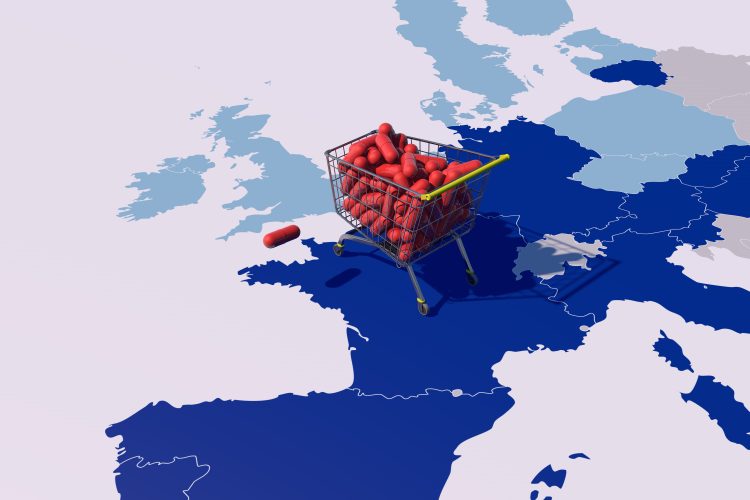Overcoming barriers to oncology combination therapies in the UK and EU
Posted: 25 September 2025 | Anastasia Stamoulou (Health Economics & HTA Analysis - IQVIA), Dr Jennifer Gaultney (Senior Principal & Function Lead for Health Economics & Health Technology Assessment - IQVIA), Saskia van Dijk (Product Manager Market Access Insights - IQVIA) | No comments yet
Colleagues at IQVIA discuss ways to expedite positive HTA outcomes for innovative combination therapies, alleviating the bottlenecks inherent in the current system.


Combination therapies in oncology provide significant potential for improving patient outcomes. With 201 novel active substances introduced globally between 2014 and 2023, oncology has been the largest therapeutic class for new drugs.1 Yet despite their clinical potential, combination therapy adoption across the UK and EU remains challenging.
Health technology assessment (HTA) agencies evaluate evidence supporting drug efficacy and safety, patient outcomes and sometimes cost-effectiveness versus other treatments already in the market. However, since value assessments, pricing and reimbursement processes for medicines are generally designed for evaluating and pricing monotherapies, these therapies tend to be made available more quickly in the EU and UK markets compared to combination therapies.2
The longer timeframe for decision-making in the approval of oncology combination therapies, despite agency critique of similar sources of uncertainty commonly mentioned for monotherapies, suggests certain drivers influence decision-making and that access is addressed differently across markets. Understanding and addressing these systemic barriers can help obtain positive decisions for combination therapies to improve patient access and outcomes.
Identifying barriers to access
To better understand the drivers behind HTA outcomes for oncology combination drugs across the UK and EU, a study analysed 127 related agency decisions issued between July 2020 and September 2023 in England and eight EU countries.3 Time-to-decision was calculated from the regulatory approval date until HTA outcome.
The analysis showed that median time to positive HTA decision for oncology combinations was faster (median: 235 days, range: 153-588) compared to all oncology treatments (median: 366, range: 182-704). However, evidence indicated that time delays for combinations persist in Germany, Spain and England. These delays may reflect deeper structural and evidentiary challenges:
- Evidence
Combination therapies frequently have gaps in clinical and real-world evidence (RWE). HTA bodies often cite concerns about endpoints (mainly data immaturity) and comparators (mainly poor quality of indirect treatment comparisons), while submissions lacking RWE generally experienced longer decision time (285 days vs. 242 days). - Fragmented policy frameworks
Each country’s HTA and reimbursement system operates independently, with differing thresholds for evidence, value and pricing. This lack of harmonisation creates uncertainty for manufacturers seeking broad access in the EU and UK. The extent to which this will be addressed by the EU HTA regulation remains to be seen.
Overcoming the challenges
As organisations recognise the barriers faced by combination therapies, strategies are emerging to facilitate faster positive decisions. These include:
Policy innovation and reform
Significant EU HTA regulation changes in 2025 designed to improve access to innovative health technologies for EU patients will likely necessitate more multi-country RWE studies. Joint clinical assessments (JCAs) began in January 2025 for oncology drugs with new active substances and advanced therapy medicinal products. JCAs aim to centralise and standardise the HTA process to streamline approvals across the EU.
In addition, some EU countries are proactively reforming their access pathways:
- France has expanded its Early Access Programme to allow faster entry for high-potential therapies4
- Ireland has introduced a Rapid Review process to streamline HTA timelines5
- Italy is leveraging its innovativeness appraisal to prioritise therapies with strong clinical promise.6
These policy shifts indicate that targeted HTA processes that recognise innovation can reduce delays and improve patient access.
Stronger evidence generation
Health technology developers (HTDs) that anticipate HTA concerns and proactively address them in reimbursement submissions may see accelerated time-to-decision. These strategies may include:
- Designing evidence generation plans that address evidence uncertainties regarding the contribution of each therapy component
- Providing robust comparative effectiveness data by adhering to methodological requirements prescribed by HTA agencies
- Building models that robustly demonstrate budget impact and cost-effectiveness with flexibility to inform negotiations across multiple components.
Early engagement with HTA bodies through scientific advice processes can also help align expectations and increase chances of success.
Cross-stakeholder collaboration
Perhaps the most powerful lever is collaboration. A collaborative approach across all stakeholders is required to overcome systemic issues – health system administrators should be involved in payer discussions, along with healthcare providers and health economists. Joint systemic solutions may require new regulations, as currently there are no comprehensive, specific guidelines or legal frameworks supporting evaluation of combination therapies.7
The next steps
HTDs can embrace both strategic and operational shifts to help overcome market access barriers. These include:
- Investment in market access expertise: providing teams with the tools and insights to navigate country-specific HTA landscapes helps develop a deeper context of reimbursement expectations.
- Prioritising RWE: use RWE to supplement clinical trial data and address evidence gaps. With the EU HTA regulation, wider evidence generation efforts will be required to address a regional context for HTA, which will increase the need for indirect treatment comparisons, including approaches informed by RWE.
- Engaging early and often: initiate dialogue with HTA bodies and payers well before submission to align evidence expectations. This would include the joint scientific consultation (JSC) process for EU HTA markets and/or national HTA scientific advice processes available.
- Exploring innovative pricing models: consider outcomes-based agreements or shared-risk models, particularly for high-cost combinations.
Combination therapies are emerging in oncology as an area of advancement, based on ongoing innovation and scientific research. Securing reimbursement needed to deliver on their significant promise requires a coordinated effort to overcome entrenched access barriers. By embracing policy reform, evidence innovation and cross-sector collaboration, organisations can help ensure that life-changing therapies reach the patients who need them most.
References
- IQVIA Institute for Human Data Science. Global trends in R&D 2024: activity, productivity, and enablers. IQVIA Institute. 2024 Feb. Available from: https://www.iqvia.com/insights/the-iqvia-institute/reports-and-publications/reports/global-trends-in-r-and-d-2024-activity-productivity-and-enablers.
- Wilsdon T, Morlotti L. Principles to support access to multi-indication oncology combinations. ISPOR Value Health. 2022 Apr. Available from: https://www.ispor.org/publications/journals/value-outcomes-spotlight/vos-archives/issue/view/moving-the-needle-on-health-policy-focus-on-outcomes-based-care/principles-to-support-access-to-multi-indication-oncology-combinations.
- Stamoulou A, van Dijk S, Gaultney J, Sitavu-Radu X. Assessment of time to HTA outcome for novel oncology combinations and decision drivers across UK and Europe. Poster presented at: ISPOR Europe; 2024 Nov. Available from: https://www.ispor.org/conferences-education/conferences/past-conferences/ispor-europe-2024/program/plenary-sessions/session/euro2024-4015/144303.
- Haute Autorité de Santé. Early access authorisation: a positive initial report and refined assessment methods. Autorité de Santé Resource Page [Internet], 2022 May 20. Available from: https://www.has-sante.fr/jcms/p_3340090/en/early-access-authorisation-a-positive-initial-report-and-refined-assessment-methods.
- Varley A, Tilson L, Fogarty E, et al. The utility of a rapid review evaluation process to a national HTA Agency. Pharmacoeconomics. 2022 Feb 4. Available from: https://pubmed.ncbi.nlm.nih.gov/34635994/.
- Garau M, Jommi C. Around the world in HTAs: Italy – what’s next? Office of Health Economics. 2023 Apr 20. Available from: https://www.ohe.org/insights/around-the-world-in-htas-italy/.
- Gaultney J, Ollendorf D, Sasane M, et al. Value attribution for oncology combination regimens: going beyond frameworks to balance innovation, access, and affordability. Frontiers in Pharmacology. 2025 Jul;16. Available from: https://www.frontiersin.org/journals/pharmacology/articles/10.3389/fphar.2025.1590944/full.
Meet the authors


Anastasia is a Health Economics and HTA Analyst at IQVIA. She specialises in projects related to HTA and joint clinical assessment submissions, with a focus on HTA strategy and dossier preparation across different therapeutic areas.


Jennifer leads IQVIA’s EMEA functional unit delivering health economics and HTA solutions. She is also a founding member of IQVIA’s HTA Centre of Excellence and has over 10 years of in-depth experience with HEOR evidence development, including RWE intended for HTA and reimbursement purposes. Her experience also includes more than 10 years of leading multiple HTA interactions and local submissions.
S

Saskia assists project teams in planning, developing and delivering projects as per global pharma client specifications. In her current role she analyses global HTA, reimbursement and market access data, assists with project management and reporting and interacts with clients to keep them updated and improve product development.
Related topics
Analysis, Cancer research, Clinical Trials, Drug Development, Oncology, Personalised Medicine, Precision Medicine, Research & Development, Therapeutics
Related organisations
IQVIA








